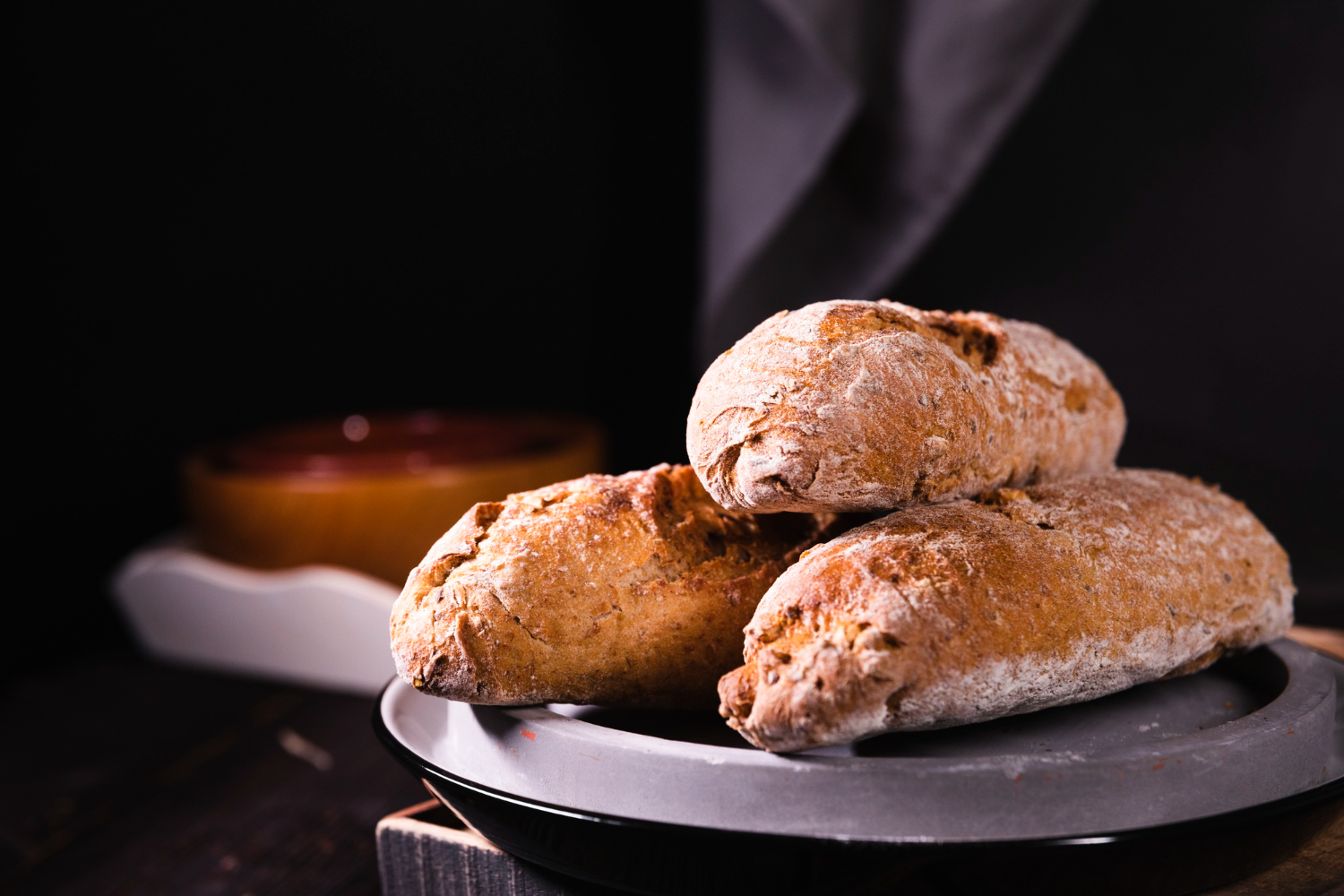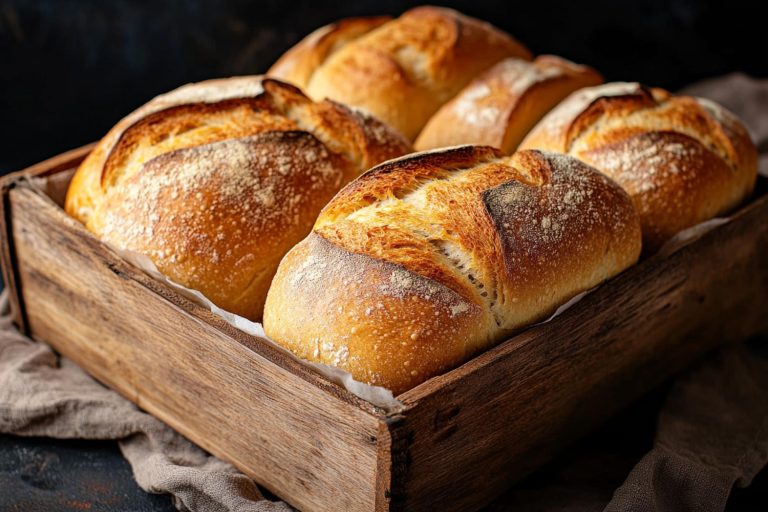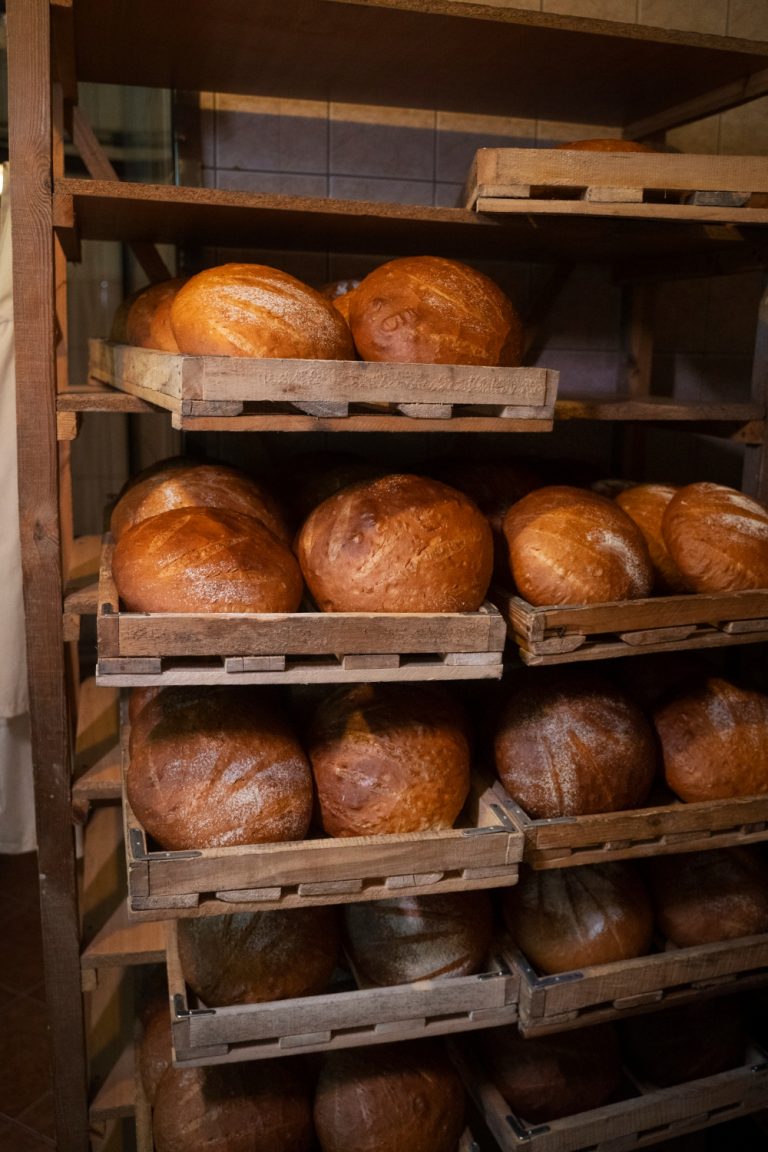How to Master Sourdough Flavor Development: An Advanced Guide
Artisanal bread baking reaches its peak complexity and reward in sourdough flavor development. Wild yeast and beneficial bacteria work together to create unique flavor profiles ranging from subtle and wheaty notes to bold, tangy complexity. Becoming skilled at controlling sourdough flavor requires bakers to manage several critical variables like fermentation time, temperature, and starter maintenance.
This guide explains the science behind sourdough flavor variations and shows you advanced techniques to achieve your desired taste profiles. You’ll learn everything about proper hydration levels, autolyze timing, and bulk fermentation methods that shape your bread’s flavor. The guide shows you specialized techniques for developing dough strength through coil folding and demonstrates how different flour combinations create distinct sourdough bread flavors.
Understanding the Science of Sourdough Flavor
The sourdough bread’s distinctive flavor emerges from an intricate dance of microorganisms at the microscopic level that has fascinated bakers for centuries. These complex biological interactions are the foundations of authentic sourdough bread production and its characteristic taste profile.
The role of wild yeast and bacteria
A sourdough starter contains a fascinating symbiotic relationship between wild yeast and lactic acid bacteria (LAB). Sourdough differs from commercial bread because it doesn’t rely only on baker’s yeast. Wild yeast species work with LAB in specific proportions, and bacteria cells usually exceed yeast cells by 100 to 1. Wild yeasts produce enzymes called amylases that break down flour starches into simple sugars and generate carbon dioxide that makes the bread rise. This creates perfect conditions where both organisms thrive and keep unwanted microorganisms away.
Lactic acid vs. acetic acid production
Sourdough’s distinctive tang comes from two types of acid-producing bacteria. Homofermentative bacteria create a mild, yogurt-like sourness by producing lactic acid. These bacteria thrive in warm, wet conditions between 70-95°F. Heterofermentative bacteria produce lactic and acetic acids, creating a sharper, vinegar-like flavor. These bacteria prefer cooler temperatures of 50-65°F and drier environments.
Factors Affecting Flavor Development
Several elements shape how sourdough develops its complex flavor profile:
- Flour composition: Whole grain flours, especially rye, create more pronounced sour flavors because of their higher mineral content and unique sugar compositions
- Temperature control: Lactic acid production thrives at warmer temperatures, while acetic acid develops better in more excellent conditions
- Hydration levels: Higher hydration creates milder flavors, but lower hydration results in more pronounced tanginess
- Fermentation time: The flavor compounds become more complex, and acids develop further during extended fermentation
The buffering capacity of flour is vital to flavor development, especially in whole-grain varieties. The higher ash content lets acids build up before pH levels drop too low. This allows bacteria to produce flavor compounds longer, creating additional amino acids and volatile compounds. These elements combine to give sourdough its signature taste profile.
A sourdough culture’s stability depends on the delicate balance between yeast and bacteria populations. This ecosystem has maintained its unique characteristics through countless generations of feeding and fermentation cycles. When it’s properly balanced, the culture becomes remarkably resistant to contamination.
Manipulating Fermentation Time and Temperature
Temperature manipulation helps bakers effectively control sourdough flavor development. Through careful temperature control during fermentation, bakers can create diverse flavor profiles, from mild to intensely sour.
Optimal fermentation temperatures for flavor
Temperature significantly affects bacterial activity and shapes your sourdough’s flavor profile. The ideal balance between yeast and bacterial activity emerges at temperatures between 75°F to 78°F (24°C to 25°C). This range creates perfect conditions where lactic and acetic acid-producing bacteria stay active without compromising the dough’s structure.
| Temperature Range | Flavor Development Effect |
|---|---|
| 85-95°F (29-35°C) | Rapid lactic acid production, mild sourness |
| 75-78°F (24-25°C) | Balanced acid development |
| 50-65°F (10-18°C) | Enhanced acetic acid production, sharper flavor |
Extended bulk fermentation techniques
Bakers achieve complex flavor profiles through extended bulk fermentation with precise time and temperature control. The dough develops deeper flavors at 76-78°F (24-26°C) for 4-5 hours during bulk fermentation. Bakers can create more pronounced sourness by reducing the pre-fermented flour percentage and extending the bulk fermentation time. This approach allows excellent acid development while the dough’s strength remains intact.
Success in extended bulk fermentation depends on these essential factors:
- The temperature stays consistent throughout the process
- Bakers perform strategic stretch and folds at 60-75 minute intervals
- The dough volume increases by 30-40% during development
- The fermentation time adapts to current ambient conditions
Cold retardation methods
Cold retardation, or retarding, slows fermentation by storing dough at lower temperatures, between 38-40°F (3-4°C). This technique gives you scheduling flexibility and boosts flavor development. The dough’s enzymatic activity continues even as yeast metabolism slows down, which creates more complex flavor compounds.
Bakers should complete bulk fermentation at room temperature before cold retarding shaped loaves for 12-48 hours to get the best results. This method ensures proper dough development and maximizes flavor. The cold environment helps produce acetic acid, which adds a more noticeable sourdough tang.
The dough’s temperature management, from cold storage to baking, is vital. Extra time is needed for the dough to reach the right proofing temperature, especially with high-hydration formulas. The balance between time, temperature, and fermentation activity shapes the final loaf’s flavor depth and complexity.
Selecting and Blending Flours for Complex Flavors
Complex sourdough flavors depend heavily on flour selection and combinations. Scientific research demonstrates that various flours promote unique bacterial communities that shape the bread’s taste profile and aromatic complexity.
Whole grain vs. refined flour
Whole grain flours include the wheat berry’s three essential parts—bran, germ, and endosperm. These components provide a rich spectrum of nutrients that help diverse microbes thrive. The bran’s mineral and fiber content shapes fermentation patterns and enhances flavor development. Refined flours excel at gluten development but lack the nutrients needed for bacterial diversity. Bakers can achieve structural strength and complex flavors by carefully balancing these flour types.
| Flour Type | Flavor Profile | Fermentation Impact |
|---|---|---|
| Whole Grain | Complex, nutty | Faster, more diverse |
| Refined | Clean, mild | Slower, more predictable |
Incorporating rye and other specialty flours
Rye flour makes an excellent flavor booster in sourdough baking and promotes up to 30 different bacterial species in mature starters—substantially more than other grain types. These diverse bacteria create more complex flavors. Ancient grains like einkorn, emmer, spelled, and kamut bring their special taste profiles to the mix:
- Einkorn brings sweet, nutty undertones
- Emmer creates caramel-like notes
- Spelt adds buttery, complex flavors
- Kamut delivers rich, buttery characteristics
Creating custom flour blends
Expert bakers mix calculated flour combinations to create specific flavor profiles and maintain the best dough structure. The best results come from using a base of strong bread flour (70-80%) mixed with specialty flour (20-30%). You can create complex flavors without losing structure by using these ratios:
A balanced blend might include:
- 75% bread flour to build structure
- 15% whole grain to add nutrition and flavor
- 10% rye flour to boost bacterial diversity
The hydration levels need adjustment based on your flour combinations. Whole grain and specialty flours need more water than refined ones. These adjustments change how you handle the dough and affect fermentation speed and flavor development.
Adjusting the ratios in your custom blends should allow you to adapt to flour’s seasonal changes. Small changes in flour combinations can greatly affect the final flavor. Exact measurements and regular monitoring help you get the same results every time.
Mastering Hydration Levels for Flavor Enhancement
The hydration level plays a significant role in controlling sourdough flavor development. The water-to-flour ratio strongly affects fermentation activity and final taste characteristics bakers can employ to achieve desired results.
How hydration affects fermentation
Water content in sourdough plays a crucial role in bacterial activity and fermentation speed. Sourdough with higher hydration, typically above 75%, creates an ideal environment for beneficial bacteria to thrive. This enhanced activity generates more organic acids that develop flavors faster.
Critical hydration effects on fermentation:
| Hydration Level | Fermentation Speed | Flavor Profile |
|---|---|---|
| 60-65% | Slow, controlled | Strong, acetic-forward |
| 70-75% | Moderate | Balanced, complex |
| 80-85% | Rapid | Mild, lactic-forward |
Temperature and hydration work together to shape specific flavor profiles in the dough. Warmer temperatures make high-hydration doughs ferment faster, so bakers need to oversee them to avoid over-fermentation.
Adjusting hydration for different flour types
Each type of flour needs different amounts of water. Whole grain flours need more water than refined flour, especially when you have high fiber and protein content. Bakers should think over these basic hydration levels to develop the best flavors:
- Bread flour: Base hydration of 65-70%
- Whole wheat flour: Increase hydration by 5-8%
- Rye flour: Increase hydration by 10-15%
- High-protein flour: Increase hydration by 3-5%
Techniques for high-hydration doughs
High-hydration doughs need special techniques to build proper structure and create unique flavors. Bakers find the coil fold method works best with doughs above 75% hydration because it lets you handle the dough gently while building strength.
You can get great results with high-hydration doughs by following these strategies:
- Begin bulk fermentation at slightly cooler temperatures (72-75°F)
- Perform coil folds every 30-45 minutes during the first 2-3 hours
- Use wet hands and bench scrapers for dough handling
- Employ cold retardation to improve dough stability
Higher hydration environments speed up flavor development during bulk fermentation. You can control this process by adjusting hydration levels and fermentation times. Higher hydration with longer bulk fermentation creates complex flavor profiles, while shorter periods with lower hydration give you more pronounced acidity.
Temperature control becomes crucial as your dough gets wetter. Your dough temperature should stay between 75-78°F during bulk fermentation to get the best bacterial activity and flavor development. Cold retardation helps develop deeper flavors in high-hydration doughs and extends fermentation time.
Advanced bakers can use the double hydration technique to fine-tune their dough. This method adds water in stages during mixing and development. You can assess your dough’s strength and adjust final hydration based on how your flour performs and what flavors you want to achieve.
Advanced Starter Management for Flavor Control
Managing sourdough starter effectively is the lifeblood of flavor development in artisanal bread baking. By carefully manipulating starter conditions, bakers can precisely control fermentation patterns and flavor profiles.
Maintaining stiff vs. liquid starters
A sourdough starter’s hydration level affects its microbial activity and flavor compounds by a lot. Stiff starters with 50-65% hydration help yeast grow more than bacteria. This creates milder flavors and improves dough strength. Liquid starters with 100% hydration or higher make bacteria thrive more. This results in stronger acidic flavors.
| Starter Type | Hydration | Flavor Profile | Fermentation Speed |
|---|---|---|---|
| Stiff | 50-65% | Mild, balanced | Slower |
| Regular | 100% | Moderate acidity | Medium |
| Liquid | >100% | Pronounced dairy notes | Faster |
Varying feeding ratios and schedules
Different feeding ratios directly affect your starter’s behavior and flavor development. Common ratios include:
- 1:1:1 (starter:water: flour) – Rapid fermentation, ideal for daily baking
- 1:2:2 – Balanced activity, suitable for room temperature maintenance
- 1:5:5 – Extended fermentation, perfect for refrigerated storage
Temperature plays a significant role in determining feeding schedules. Your starter needs feeding every 12-24 hours when kept at room temperature (70-75°F). Refrigerated starters remain stable between feedings for 7-10 days and develop more complex flavor compounds during cold storage.
Using mature vs. young starters in baking
Starter maturity greatly affects bread flavor when you use it for baking. A mature starter reaches peak activity 4-8 hours after feeding, giving you the best leavening power with balanced acidity. These starters display clear fermentation signs such as:
- Predictable rise and fall patterns
- Stable mixture of lactic acid bacteria and wild yeasts
- Consistent fermentation timing
- Regular bubble formation and aroma development
Young starters are used 2-4 hours after feeding. Add milder flavors with less acidity to your bread. Bakers find this method works better to showcase grain flavors than sourdough tang. Young starter bacterial populations haven’t yet produced much acid, leading to gentler fermentation profiles.
Bakers can better control flavors through smart temperature management. Stiff starters at slightly lower temperatures (65-68°F) create more acetic acid, while liquid starters at warmer temperatures (75-78°F) develop more lactic acid. This knowledge helps bakers adjust their starter management to achieve specific flavor results.
Different starter types show varying levels of stability. Stiff starters handle cold storage better, making them perfect for bakers who feed their starters less often. Liquid starters ferment faster but mix easier into high-hydration doughs and usually give more consistent results in daily baking.
Many experienced bakers keep multiple starters at different hydration levels and blend their characteristics to create custom flavor profiles. This method helps them control fermentation timing while creating complex flavor combinations that a single starter type couldn’t achieve.
Flavor-Boosting Techniques and Additions
Sourdough bread’s advanced flavor development requires more than simple fermentation control. Bakers who become skilled at specialized techniques and targeted ingredient additions can create unique flavor profiles that maintain optimal dough structure.
Autolyze and its effect on flavor
Autolyze creates magic when flour and water combine during rest before other ingredients join the mix. This fundamental process boosts flavor development as enzymatic activity takes place. Amylase enzymes work to break down complex starches into simple sugars that become readily available food for fermentation. Bakers typically allow 20-60 minutes for this process, though specific flour types need different timing:
| Flour Type | Autolyze Duration | Flavor Impact |
|---|---|---|
| White Bread Flour | 20-30 minutes | Enhanced wheat notes |
| Whole Wheat | 30-45 minutes | Deeper grain complexity |
| High Protein | 45-60 minutes | Improved extensibility |
Whole grain doughs benefit significantly from the autolyze technique. The process softens bran particles and minimizes their effect on gluten development. Your dough structure improves while the complex flavors of whole grains remain intact.
Incorporating soakers and preferments
Soakers and preferments are two different yet complementary methods for improving flavor. Soakers require grains or seeds to be steeped in water before being added to the dough. Preferments add fermented flour mixtures that create complex flavors.
An adequately prepared preferment adds up to 30% of the flour weight and creates intricate flavors through more extended fermentation periods. Bakers commonly use these preferment types:
- Poolish: Equal parts flour and water with minimal yeast
- Biga: Stiff preferment with lower hydration
- Levain: Sourdough-based preferment
- Pâte fermentée: Fermented dough from the previous batch
Hot soakers work best with whole grains. Boiling water helps gelatinize starches and soften grain particles, resulting in better texture and flavor extraction. The soakers should reach room temperature before you mix them into the final dough.
Adding flavor enhancers like seeds and grains
Seeds and grains added strategically can improve the taste of your sourdough and boost its nutritional value. The right timing and preparation are vital for the best results.
Seeds need toasting before you mix them into the dough. This helps release their natural oils and makes their flavors stronger. Here are some common additions and how to prepare them:
| Addition Type | Preparation Method | Incorporation Timing |
|---|---|---|
| Pumpkin Seeds | Light toasting | Second fold |
| Sunflower Seeds | Raw or toasted | Original mix |
| Flax Seeds | Soaked | After autolyze |
| Sesame Seeds | Toasted | Final fold |
Bakers must adjust their dough hydration to balance out moisture absorption from seeds and grains. A good rule is to cut the recipe’s water by about 50% of any soaked additions’ weight. This helps maintain the right dough consistency.
The timing of your additions can affect both flavor development and dough structure. Hard ingredients like toasted seeds should be added during the early stretch and folds. This ensures they spread evenly without damaging the gluten networks. You can add softer ingredients during later folds to keep them intact.
Your seed additions will work best if you:
- Keep total additions to 20% of flour weight
- Adjust hydration based on absorption rates
- Think over temperature’s effect on fermentation
- Watch dough strength as you mix
Chia and flax seeds need special attention because they absorb lots of water. Soak them first and factor their moisture into your final dough recipe. Remember to subtract the soaking water from your recipe’s total hydration to keep the dough consistency right.
Temperature control becomes especially important with enriched doughs that have multiple additions. Soaked grains and seeds can speed up fermentation through increased enzyme activity. You might need to adjust your bulk fermentation timing and temperature control approach.
Conclusion
The exceptional flavor of sourdough bread comes from carefully controlling several connected variables that play a vital role in baking. Bakers can confidently adjust temperature, time, and hydration levels with their knowledge of acid production, bacterial activity, and fermentation dynamics. The proper flour selection and advanced starter management techniques give bakers more tools to achieve specific flavor profiles. These elements work together cooperatively and help bakers create signature bread with unique characteristics and complexity.
Skilled at sourdough takes dedication, experimentation, and attention to detail, while bakers learn to balance these elements. Professional bakers know each loaf, which allows them to improve their craft through minor process adjustments. The Yeast We Can Do offers premium small-batch starters to passionate home bakers and restaurant owners who want to create exceptional bread and pizza with authentic sourdough flavor. Bakers can email john@theyeastwecando.com to start their artisanal baking trip. Regular practice and application of these advanced techniques help bakers develop a natural feel for their dough, leading to consistently outstanding results and showcasing sourdough’s remarkable flavor potential.
FAQs
How can I enhance the sourness of my sourdough bread?
To achieve a more robust sour flavor in your sourdough, consider maintaining your starter at a lower hydration level by using a higher ratio of flour to water. Incorporating whole-grain flours can also help, as these are preferred by acid-producing bacteria. Additionally, retain the hooch, or brown liquid layer, that forms on top of a hungry sourdough starter instead of discarding it.
What are the key factors that influence the flavor of sourdough bread?
Several factors significantly impact the flavor of sourdough bread, including the health of your starter, the levels of organic acids in the bread dough, and the interactions between the levain, dough, fermentation, and proofing processes over time.
What techniques can make sourdough bread taste better?
Maintaining a higher dough temperature, ideally between 85-95ºF, can enhance the activity of Lactobacillus, leading to quicker production of lactic acid bacteria. This results in a milder, more pleasantly sour loaf.
Why does using whole wheat flour result in a sourdough that is more sour?
Whole wheat and rye flours contain higher mineral content and enzymes promoting sourdough acid production. The minerals act as a buffer in the dough, allowing for more acid production during extended fermentation, which contributes to a sourer taste.
How can I make my sourdough bread have a more distinct flavor?
If your sourdough bread consistently tastes like regular bread despite various attempts, consider experimenting with different fermentation times and temperatures or using different types of flours, such as rye or whole wheat. These changes can help develop a more pronounced and unique flavor in your sourdough bread.






